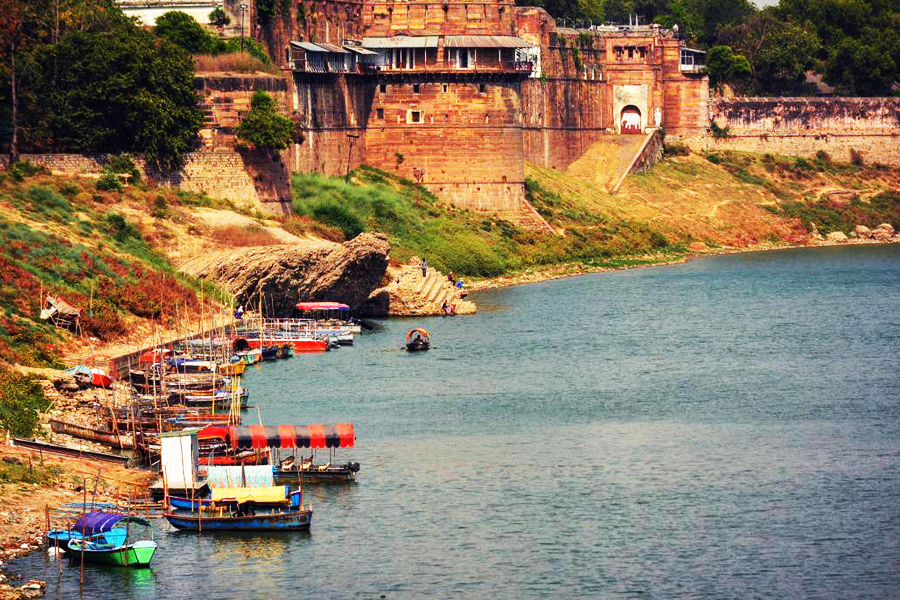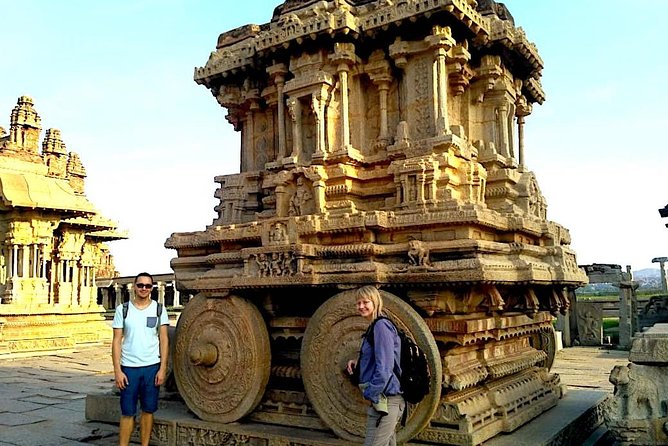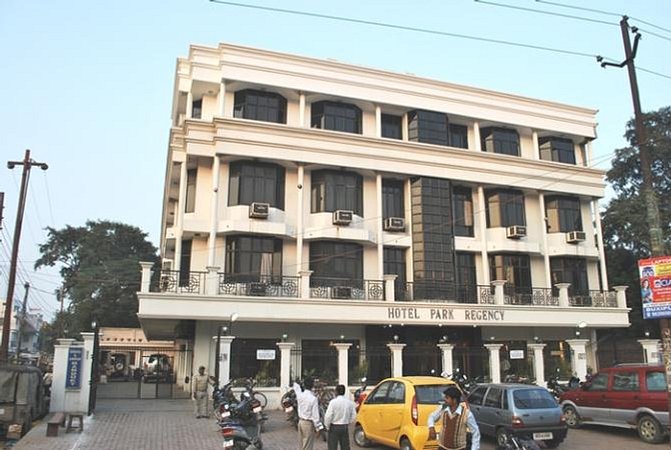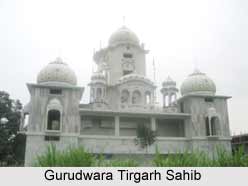Prayagraj Fort is an architectural marvel in India. It showcases rich history and culture.
Nestled by the banks of the Yamuna River, Prayagraj Fort stands as a testament to India’s glorious past. Built by Emperor Akbar in 1583, this fort has witnessed centuries of history unfold within its walls. It serves as a reminder of the Mughal Empire’s architectural brilliance.
The fort’s massive structure, intricate carvings, and ancient relics draw thousands of visitors each year. Exploring Prayagraj Fort is like stepping back in time, offering a glimpse into the lives of emperors and warriors. Whether you’re a history buff or a curious traveler, Prayagraj Fort promises an enriching experience. Join us as we delve into the fascinating stories and secrets of this iconic fort.
Introduction To Prayagraj Fort
Prayagraj Fort stands majestically on the banks of the Yamuna River in Uttar Pradesh. This grand fort is a testament to India’s rich history and architectural brilliance. Built by Emperor Akbar in 1583, it showcases the splendor of Mughal architecture.
Historical Significance
Prayagraj Fort has witnessed centuries of history unfold. It served as a strategic military base during Mughal rule. The fort played a crucial role in defense and administration. Akbar chose this site for its strategic location.
The fort’s walls have stories to tell. From royal battles to governance, it has seen it all. It symbolizes the power and grandeur of the Mughal Empire. The fort is a reminder of India’s glorious past.
Architectural Marvel
The architecture of Prayagraj Fort is awe-inspiring. It combines Hindu and Islamic styles. The fort has massive walls, intricate carvings, and majestic gates. The design reflects the artistic prowess of the Mughal era.
Inside, you’ll find beautiful palaces and spacious courtyards. The fort also houses temples and mosques. Each structure within the fort is a piece of art. The craftsmanship is impeccable.
The fort’s layout is well-planned. It includes defense mechanisms like watchtowers and secret tunnels. These features highlight the advanced engineering of the time. Prayagraj Fort is truly an architectural marvel.
Historical Background
The historical background of Prayagraj Fort is rich and fascinating. This ancient fort stands as a testament to India’s vibrant history and heritage. It has witnessed several significant events, playing a crucial role over centuries.
Founding And Early Years
Prayagraj Fort, also known as Allahabad Fort, was built in 1583. Emperor Akbar, one of the greatest rulers of the Mughal dynasty, ordered its construction. He chose the confluence of the Ganges and Yamuna rivers for its strategic importance. The fort was designed to be both a military stronghold and a majestic residence. Its massive walls and grand gateways reflect the architectural brilliance of the Mughal era.
In its early years, the fort served as a key defensive structure. It protected the city from invasions and uprisings. The fort’s location made it a crucial point of control for the Mughal Empire. Over time, it became a symbol of power and authority in the region.
Role In Indian History
Prayagraj Fort played a significant role in India’s history. During the First War of Indian Independence in 1857, the fort was a focal point. The British East India Company used it as a military base. They fortified it to suppress the rebellion.
Later, the fort witnessed many important events in the freedom struggle. Indian leaders held secret meetings here. They planned strategies to fight British rule. The fort stands as a reminder of the bravery and sacrifices made during those times.
Today, Prayagraj Fort is a popular tourist attraction. It offers a glimpse into India’s rich past. The fort’s architecture and historical significance continue to attract visitors from all over the world.
Architectural Features
Prayagraj Fort is a marvel of Mughal architecture. It stands majestically on the banks of the Yamuna River. Its design reflects the grandeur and elegance of the era. Exploring its architectural features is like stepping back in time.
Design And Layout
The fort’s design is symmetrical and well-planned. It has massive walls that enclose a vast area. The main entrance is grand, adorned with intricate carvings. Inside, there are numerous courtyards and gardens. The layout ensures a blend of security and beauty. Each section of the fort serves a distinct purpose. There are areas for administration, living quarters, and worship.
The fort also includes several watchtowers. These towers offer stunning views of the surrounding landscape. The design incorporates both defensive and aesthetic elements. It embodies the architectural prowess of the Mughal era.
Unique Elements
Prayagraj Fort boasts several unique features. The most notable is its underground palace. This palace remains cool even during hot summers. It showcases advanced engineering skills of the builders.
Another remarkable element is the Ashoka Pillar. This ancient stone pillar stands tall within the fort. It dates back to the 3rd century BCE. The pillar bears inscriptions from Ashoka’s reign. These inscriptions provide historical insights.
The fort also houses a large hall called the Diwan-i-Aam. This hall served as a public audience chamber. It has beautiful arches and columns. The design reflects Mughal artistry and craftsmanship.
Each element of Prayagraj Fort tells a story. It represents a blend of history, culture, and art. The fort remains a testament to the architectural brilliance of its time.

Credit: en.wikipedia.org
Cultural Importance
Prayagraj Fort is a symbol of India’s rich cultural tapestry. Built by Emperor Akbar, it stands as a testament to history and heritage. This fort has witnessed countless cultural events and holds deep meaning for many. Its walls echo stories of devotion, tradition, and community gatherings.
Religious Significance
Prayagraj Fort stands near the confluence of three sacred rivers. This makes it a key site for Hindu rituals. Pilgrims visit the fort during the Kumbh Mela. They believe in the spiritual power of the fort’s location. Many think prayers here bring blessings and peace.
Festivals And Events
The fort comes alive during the Kumbh Mela. This festival draws millions from around the world. People set up camps near the fort. They participate in rituals, prayers, and holy dips in the rivers.
Other local festivals also take place at Prayagraj Fort. These events showcase traditional music, dance, and food. The fort transforms into a hub of cultural activities. Visitors experience the vibrant culture of Prayagraj during these times.
Major Attractions
Prayagraj Fort, also known as Allahabad Fort, stands as a testament to India’s rich heritage. Built by Emperor Akbar in 1583, this fort offers a glimpse into the past. Visitors can explore its major attractions, which include historic monuments and breathtaking views.
Key Monuments
One notable monument within Prayagraj Fort is the Ashoka Pillar. This ancient column, dating back to the 3rd century BCE, features inscriptions from Emperor Ashoka. It stands tall and proud, a symbol of enduring history.
The Saraswati Koop is another significant site. This well is believed to be the source of the mystical Saraswati River. Many visit it seeking blessings and to witness its spiritual significance.
The Patalpuri Temple is also a key attraction. This underground temple is dedicated to various Hindu deities. It offers a serene and divine atmosphere for worshippers.
Scenic Views
Prayagraj Fort offers stunning views of the Triveni Sangam. This is the confluence of the Ganges, Yamuna, and Saraswati rivers. The sight of the merging waters is mesmerizing.
The fort’s elevated position provides panoramic views of the surrounding landscape. Visitors can see lush greenery and the flowing rivers from the fort’s ramparts. These scenic views are perfect for photography and contemplation.
The fort’s gardens are also worth a visit. They offer a peaceful retreat with well-maintained lawns and blooming flowers. The gardens are ideal for a leisurely stroll or a moment of relaxation.
Archaeological Discoveries
Prayagraj Fort, a majestic fortification located in the city of Prayagraj, India, has long been a subject of fascination for historians and archaeologists alike. The fort, which dates back to the reign of Emperor Akbar in the 16th century, has been a silent witness to numerous historical events. Recent archaeological discoveries within the fort have shed new light on its rich past, offering fresh insights into the lives of those who once inhabited it. Let’s delve into some of the most intriguing findings from the latest excavations.
Recent Excavations
Recent excavations at Prayagraj Fort have unearthed numerous artifacts that provide a glimpse into the fort’s storied history. Archaeologists have been meticulously digging through layers of time, revealing structures and objects that were previously hidden from view.
- Pottery and Ceramics: During the latest digs, a variety of pottery and ceramic pieces have been found. These items, adorned with intricate designs, suggest a thriving community that valued art and craftsmanship.
- Coins and Seals: Several coins and seals, dating back to different periods, have been discovered. These finds help historians piece together the economic and administrative history of the region.
- Ancient Tools: The discovery of ancient tools indicates the presence of skilled laborers who contributed to the fort’s construction and maintenance.
These excavations are not just about unearthing objects; they are about understanding the fort’s role in the broader historical context. Each item tells a story, adding depth to our knowledge of the past.
Significant Finds
Among the numerous artifacts unearthed, some stand out due to their historical significance and the stories they tell.
1. The Underground Chambers
One of the most exciting discoveries has been the underground chambers. These chambers, likely used for storage or as secret passages, offer a new perspective on the fort’s strategic importance. Imagine the thrill of walking through these hidden corridors, feeling the echoes of history around you.
2. Inscriptions and Manuscripts
Inscriptions and manuscripts found within the fort’s precincts have provided valuable information about the cultural and religious practices of the time. These texts, written in ancient scripts, are being carefully studied and translated. What hidden stories might these ancient writings reveal?
3. Architectural Marvels
The discovery of intricate carvings and architectural elements showcases the advanced engineering skills of the period. The craftsmanship evident in these structures speaks volumes about the artisans’ expertise and the aesthetic sensibilities of the era.
As you explore these discoveries, picture yourself as part of the archaeological team, uncovering the secrets of Prayagraj Fort. What insights might you gain about the people who once called this place home? How might these findings change our understanding of history?
The ongoing excavations at Prayagraj Fort continue to reveal fascinating insights, each find adding a new piece to the puzzle of the past. Whether you’re a history buff or simply curious about the world, these discoveries offer a tantalizing glimpse into a bygone era.
Tourist Experience
Visiting the Prayagraj Fort is an unforgettable experience. This historic structure, built by Emperor Akbar in 1583, stands majestically on the banks of the Yamuna River. The grand architecture and historical significance of this fort make it a must-visit destination for history buffs and casual travelers alike. As you walk through its ancient corridors, you can almost hear the whispers of the past.
Visitor Information
Before you set off to explore Prayagraj Fort, it’s essential to know a few key details. The fort is open to visitors from 7:00 AM to 6:00 PM daily. Entry fees are quite reasonable, ensuring that this gem is accessible to everyone. It’s advisable to hire a local guide. They offer valuable insights and narrate fascinating stories about the fort’s history.
- Location: Prayagraj, Uttar Pradesh, India
- Entry Fees: INR 20 for Indians, INR 250 for foreigners
- Timings: 7:00 AM – 6:00 PM
- Best Mode of Transport: Auto-rickshaw or taxi
Ensure you carry water and wear comfortable walking shoes. The fort’s expanse demands quite a bit of walking, but every step is worth it.
Best Times To Visit
The best times to visit Prayagraj Fort are during the cooler months from October to March. The weather is pleasant, making your exploration comfortable. Additionally, visiting early in the morning or late in the afternoon helps avoid the midday sun.
During the annual Kumbh Mela, held between January and February, Prayagraj becomes a hub of activity. The fort offers a unique vantage point to witness the confluence of traditions and modernity. However, be prepared for larger crowds during this period.
Have you ever wondered how experiencing a place during its peak cultural event can transform your perspective? Visiting Prayagraj Fort during Kumbh Mela can offer just that—a blend of history and living tradition.
Whether you are a history enthusiast or a casual traveler, Prayagraj Fort promises an enriching experience. Plan your visit, absorb the stories etched in its walls, and let the fort’s grandeur captivate you.

Credit: www.thekumbhyatra.com
Conservation Efforts
Prayagraj Fort’s conservation efforts focus on preserving its rich history and architecture. Restoration projects aim to maintain its ancient structures and cultural heritage.
### Conservation Efforts The Prayagraj Fort stands as a testament to the rich history and cultural heritage of India. Preserving such an ancient monument requires dedicated conservation efforts. Let’s delve into the specific initiatives aimed at maintaining the fort’s grandeur for future generations.Restoration Projects
One of the key conservation efforts involves extensive restoration projects. You might wonder, what does it take to restore such a historical structure? Experts meticulously analyze the fort’s condition and identify areas that need urgent attention. For instance, the outer walls, which have faced centuries of wear and tear, undergo careful reconstruction using traditional materials. This ensures the fort retains its authentic look. Teams of skilled artisans work tirelessly to repair intricate carvings and restore faded frescoes. As you walk through the fort, noticing the revived details can make you appreciate the effort involved. Think about the last time you saw a historic site. Did you ever wonder about the people behind its preservation? The work done here at Prayagraj Fort is a labor of love and dedication.Preserving Heritage
Preserving the fort’s heritage goes beyond physical restoration. It involves protecting and promoting its historical significance. One effective strategy is educational programs. Schools and colleges organize trips to the fort, offering students a chance to learn about its history firsthand. Imagine the curiosity and excitement that fills the air as young minds explore the fort and hear stories from the past. Additionally, digital initiatives play a crucial role in heritage preservation. Virtual tours and online archives make the fort accessible to a global audience. You can explore its grandeur from the comfort of your home, making history more engaging and interactive. Community involvement is also pivotal. Local residents actively participate in conservation efforts, ensuring the fort remains a source of pride and identity. Have you ever been part of a community project? If so, you know the sense of ownership and connection it fosters. By focusing on both physical restoration and heritage preservation, the efforts at Prayagraj Fort exemplify a comprehensive approach. The goal is not just to preserve a structure, but to keep the history, culture, and stories alive for future generations.
Credit: www.britannica.com
Frequently Asked Questions
Who Built Prayagraj Fort?
Emperor Akbar built the Prayagraj Fort. Located in Uttar Pradesh, India, it was constructed in 1583. The fort is a historical landmark.
Why Is Allahabad Fort Closed?
Allahabad Fort is closed due to security reasons and restricted access by the Indian Army. Public entry is limited.
What Is Special About Prayagraj?
Prayagraj is known for the Triveni Sangam, where the Ganges, Yamuna, and Saraswati rivers meet. It hosts the Kumbh Mela, attracting millions of pilgrims. The city boasts rich cultural heritage and historical significance.
Which Fort Was Made By Akbar?
Akbar built the Agra Fort. This impressive structure is located in Agra, India. It is a UNESCO World Heritage site. The fort showcases Mughal architecture and historical significance.
Conclusion
Prayagraj Fort is a timeless marvel. Its history captivates every visitor. The architecture showcases India’s rich heritage. Exploring this fort offers a glimpse into the past. A visit here enriches your cultural understanding. The fort stands as a testament to India’s grandeur.
Experience the legacy firsthand. Plan your trip to Prayagraj Fort soon. You won’t regret this journey into history.
{ “@context”: “https://schema.org”, “@type”: “FAQPage”, “mainEntity”: [ { “@type”: “Question”, “name”: “Who built Prayagraj fort?”, “acceptedAnswer”: { “@type”: “Answer”, “text”: “Emperor Akbar built the Prayagraj Fort. Located in Uttar Pradesh, India, it was constructed in 1583. The fort is a historical landmark.” } } , { “@type”: “Question”, “name”: “Why is Allahabad Fort closed?”, “acceptedAnswer”: { “@type”: “Answer”, “text”: “Allahabad Fort is closed due to security reasons and restricted access by the Indian Army. Public entry is limited.” } } , { “@type”: “Question”, “name”: “What is special about Prayagraj?”, “acceptedAnswer”: { “@type”: “Answer”, “text”: “Prayagraj is known for the Triveni Sangam, where the Ganges, Yamuna, and Saraswati rivers meet. It hosts the Kumbh Mela, attracting millions of pilgrims. The city boasts rich cultural heritage and historical significance.” } } , { “@type”: “Question”, “name”: “Which fort was made by Akbar?”, “acceptedAnswer”: { “@type”: “Answer”, “text”: “Akbar built the Agra Fort. This impressive structure is located in Agra, India. It is a UNESCO World Heritage site. The fort showcases Mughal architecture and historical significance.” } } ] }




